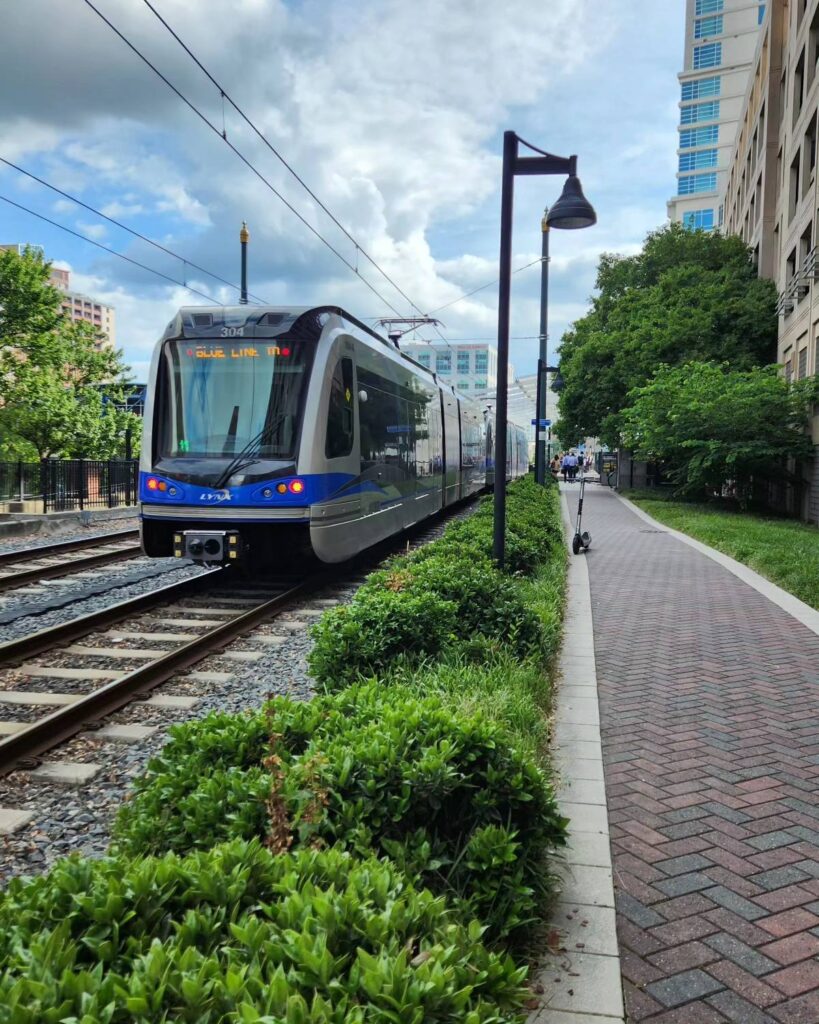Guest post by Pauly Tarricone, member of the Bloomington Bicycle and Pedestrian Safety Commission and MAAA-MPA Candidate at Indiana University, O’Neill School of Public and Environmental Affairs
I had the distinct privilege of attending the Strong Towns National Gathering this past week in Charlotte, North Carolina. The message of Strong Towns is simple; the predominant development pattern of the last 100 years is not working. The horizontal expansion of liabilities (including roads, utilities, and parking lots) of most suburbs and many cities is exceeding the return on investment, slowly draining the wealth of our communities and making them more susceptible to insolvency.

Charlotte, North Carolina’s Rail Trail is a linear park with public art through the city. The public trail is a work in progress that follows along the Blue Line.
Strong Towns advocates for safer, shared streets and zoning policies that prioritize the interconnection and commerce of people, rather than the high-volume, high-speed throughput of automobiles. By starting on the street and working toward land use, we may create neighborhoods that foster the generation of local wealth, enhancing the resilience and fortitude of our communities.
Bloomington has not been immune to unsustainable development practices, but it is far from the worst offender and in fact does many things well for its residents. There are, however, many opportunities for improvement, and I hope to share some of my takeaways that may shorten the gap between where we are and where we could be.
5) Think small in order to think big.
Opportunities for the creation of local wealth start on a small-scale. Strong Towns founder Charles Marohn has provided 4 basic steps to this process:
- Identify a problem in your community.
- Identify the next smallest action that can be done to address that problem.
- Complete that action.
- Repeat.
Strong Towns emphasizes incrementalism and dynamism in its messaging. It means accepting humility in what can be done to improve things for our neighbors, combined with a tenacity that keeps our efforts self-replenishing.
Before we can collaborate in our communities, we must first earn each other’s trust.
4) Seek to understand rather than convince.
Before we can identify the “what,” we must start with the “why” and the “how.” No matter how confident we are that we have the most correct information, if we don’t prioritize efforts to learn from our fellow community members first, then our efforts are certainly for naught. Before we can collaborate in our communities, we must first earn each other’s trust.
3) Be willing to ask yourself and your neighbors: “What do you want? What are you willing to pay for it?”
The first question is more easily answered than the second. We must also understand that none of our actions exist in a vacuum, and any sense of actual cost must be considered from a collective perspective.
2) Our most overlooked communities often hold the greatest productivity.
The movement of dollars collected from taxes paints what is, for many, a counterintuitive picture: wealthy, sprawling neighborhoods on the periphery generally receive more dollars toward city services than they provide (they’re subsidized). More dense, often disinvested, neighborhoods generally contribute more dollars toward city services than they receive (they’re providing subsidies). This deep-seated problem of city financing is not only deeply unjust, it is entirely unsustainable and leaves city budgets in a fragile state. For further data on pattern, check out the incredible work of the organization Urban3.
Advocates for safe transportation options and for abundant housing availability often espouse a passion that is received as hostility.
1) Impatience does not make for a good driver, but it does make for a good navigator.
Advocates for safe transportation options and for abundant housing availability often espouse a passion that is received as hostility. No matter who has facts on the side of whom, this can alienate people from the compromise necessary to enact the change our communities so desperately need. However, impatience still serves an important role; it guides us toward the most fragile parts of our communities and presents us the opportunity to make them resilient, dynamic, and equitable: “in a word – strong.” While it often starts with just one person, it can’t be finished without the whole community working toward its own strength.
For more information on Strong Towns, I would highly recommend the following books:
Strong Towns: A Bottom-Up Revolution to Rebuild American Prosperity by Charles Marohn
Reclaiming Your Community: You Don’t Have to Move out of Your Neighborhood to Live in a Better One by Majora Carter
Dream Play Build: Hands-On Community Engagement for Enduring Spaces and Places by James Rojas and John Kamp
Confessions of a Recovering Engineer: Transportation for a Strong Town by Charles Marohn
Hi Pauly–it was great to meet you in Charlotte! Thanks for this thoughtful summary of the Strong Towns framework! Even though focused on Bloomington, it’s really applicable to any place. Someone once said that 80% of success is showing up, and the Strong Towns process, rooted in local conversations, it a great way to help us all show up! I’ve been thinking about that in the context of my own neighborhood, which is an inner-ring suburb that has suffered from disinvestment and enforced car-dependency. We’ve started a conversation about smart development in the neighborhood, but it’s in its infancy. I don’t know how many people will want to read lots of books, but I think there are some Strong Towns and other videos that would help the conversation along. *And* your blog post is a great starting point! Thanks again!